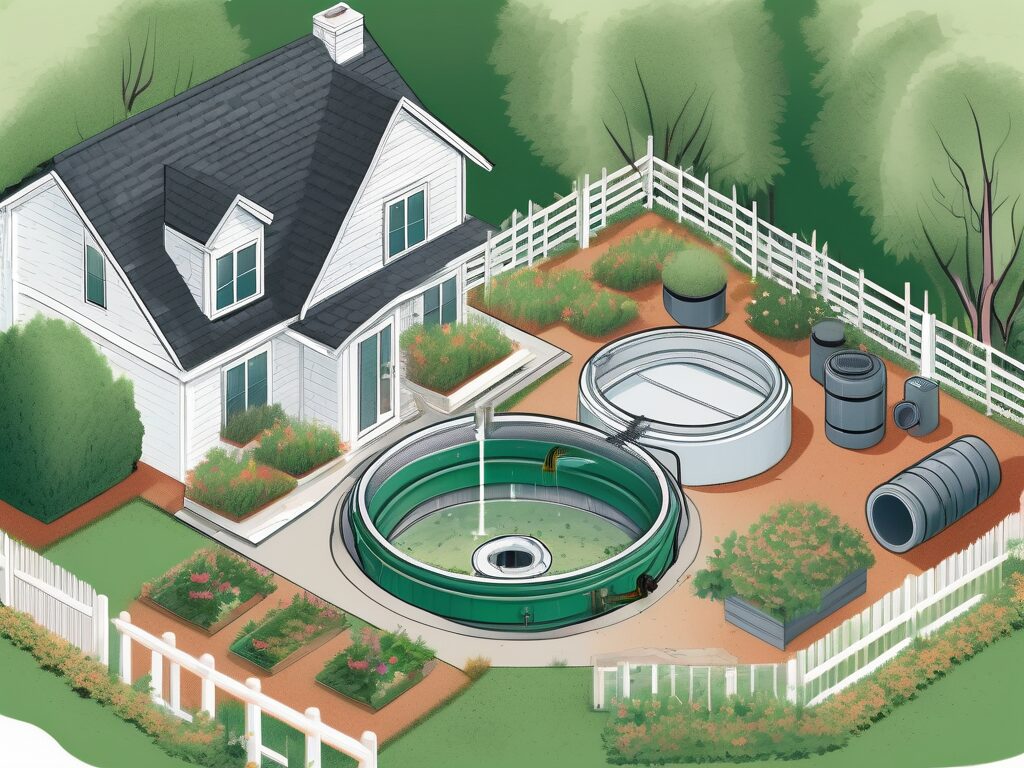
Agent A-Team or Solo Superhero? Finding the Right Real Estate Partner for Your Selling Journey in Wildwood Florida
When it comes to selling your home in Wildwood, Florida,…
January 29, 2024
Regular septic tank maintenance is essential for the proper functioning and longevity of your home’s septic system. Neglecting your septic system can lead to costly repairs and even pose health hazards to you and your family. Understanding your septic system and the necessary maintenance tasks will ensure its optimal performance and prevent any potential issues.
One of the first steps in maintaining your septic system is understanding its location and components. Septic systems are underground wastewater treatment structures that are common in residential areas not served by public sewage systems. It consists of a septic tank, a distribution box (D-Box), and a drain field.
Septic systems play a vital role in treating and disposing of household wastewater. They are designed to separate solid waste from the liquid, allowing the liquid to flow into the drain field for further treatment and absorption into the soil. This process helps protect the environment by preventing contamination of groundwater and nearby bodies of water.
Finding your septic field is crucial for maintenance purposes. Start by checking the layout of your property’s plans or consulting with your local health department. They may have records indicating the approximate location of your septic system. However, keep in mind that these records may not always be accurate, especially if your property has undergone changes or renovations.
If you’re unable to find your septic field using the plans or records, consider looking for visible signs on the surface. Manhole covers or inspection ports are often installed to provide access to the septic tank and distribution box. These can be indicators of the general area where your septic system is located.
However, it’s important to note that the septic field itself is usually not visible from the surface. It is buried beneath the ground, typically covered with soil and vegetation. If you’re having difficulty locating your septic field, it’s advisable to hire a professional septic system inspector or a licensed septic contractor. They have the expertise and equipment to accurately locate your septic system.
Septic systems come in different types, each with its own design and functionality. The most common types include conventional septic systems, aerobic treatment units, and mound systems.
Conventional septic systems are the traditional and most widely used type. They consist of a septic tank, a distribution box, and a drain field. These systems rely on natural processes to treat wastewater and require regular maintenance to ensure proper functioning.
Aerobic treatment units (ATUs) are an alternative to conventional septic systems. They use oxygen and bacteria to break down and treat wastewater more efficiently. ATUs are often used in areas with high water tables or soil conditions that are not suitable for conventional systems.
Mound systems are designed for properties with shallow soil depth or high water tables. They involve the construction of an elevated drain field, or mound, to allow for proper wastewater treatment and disposal.
To determine the type of septic system installed in your home, you can check your system’s documentation or consult a professional septic system inspector. They can provide you with detailed information about your specific system and its maintenance requirements.
Understanding the materials used to construct your septic tank system is essential for its maintenance and longevity. Septic tanks can be made from different materials, including concrete, fiberglass, or plastic.
Concrete septic tanks are the most common and have been used for many years. They are known for their durability and can last for several decades if properly maintained. However, concrete tanks may be susceptible to cracking or corrosion over time, especially if exposed to harsh chemicals or extreme weather conditions.
Fiberglass septic tanks are a popular alternative to concrete tanks. They are lightweight, resistant to corrosion, and easier to install. Fiberglass tanks also have a longer lifespan compared to concrete tanks. However, they may be more expensive upfront and require careful handling during installation to prevent damage.
Plastic septic tanks are another option available in the market. They are lightweight, easy to handle, and resistant to corrosion. Plastic tanks are often used in areas with difficult access or where weight restrictions are a concern. However, they may be less durable compared to concrete or fiberglass tanks and may require more frequent inspections and maintenance.
Knowing the material used in your septic tank system will help you take appropriate care of it. For example, if you have a concrete tank, you may need to periodically inspect it for cracks and ensure it is properly sealed. On the other hand, if you have a fiberglass tank, you may need to be cautious when using strong chemicals that could damage the tank’s surface.
The size of your septic system is an important factor in its proper functioning. It is determined based on factors such as the number of bedrooms in your home and the water usage habits of your household.
A septic system’s size is primarily determined by the capacity of the septic tank. The tank needs to be large enough to hold the wastewater generated by your household between pump-outs. If the tank is too small, it may fill up quickly, leading to potential issues such as sewage backups or system failure.
To determine the appropriate size for your septic system, it’s recommended to consult a professional septic system designer or a licensed septic contractor. They can assess your household’s water usage, the number of occupants, and other relevant factors to provide you with recommendations for the ideal tank size.
Properly sizing your septic system ensures that it can effectively handle the wastewater produced by your household, reducing the risk of system malfunctions and costly repairs in the future.
Regular maintenance tasks will keep your septic system functioning properly and prevent any potential issues. Taking care of your septic system is crucial for the health and safety of your home and the environment. Here are some important maintenance tasks to keep in mind:
Regular inspections by a qualified professional are crucial to identify any septic system problems early on. They will assess the condition of your septic tank, check for leaks or blockages, and ensure all components are functioning correctly. Inspections should be conducted at least once every three years. During the inspection, the professional will also evaluate the level of sludge and scum in the tank. If the levels are too high, they will recommend pumping the tank to prevent any potential issues.
Septic tank inspections are not only important for the functioning of your system but also for the safety of your property. A malfunctioning septic system can lead to sewage backups, which can cause extensive damage to your home and pose health risks to your family.
The distribution box (D-Box) is a critical component that evenly distributes wastewater from the septic tank to the drain field. Over time, the D-Box may become clogged or damaged, leading to uneven wastewater distribution and potential system failure. Regularly inspecting and maintaining the D-Box will prevent such issues.
During the inspection, the professional will check for any signs of damage or blockages in the D-Box. They will also ensure that the distribution pipes are properly connected and functioning. If any issues are detected, they will recommend repairs or replacements to ensure the efficient operation of your septic system.
Septic tanks require periodic pumping to remove accumulated solids and prevent clogs. The frequency of pumping depends on factors like the size of your tank and the number of occupants in your home. Generally, septic tanks should be pumped every three to five years. However, if you have a larger household or if you use a garbage disposal frequently, more frequent pumping may be necessary.
Consulting a professional is crucial to determine the appropriate pumping schedule for your septic system. They will consider the size of your tank, the number of occupants, and your water usage patterns to provide you with an accurate recommendation. Regular pumping will help maintain the efficiency and longevity of your septic system.
While regular pumping is necessary, certain signs indicate that your septic tank may need immediate attention. It’s important to be aware of these signs to prevent any potential issues. Signs that your septic tank needs to be emptied include slow drains, gurgling sounds, foul odors, or sewage backups.
If you notice any of these signs, it’s crucial to contact a professional to inspect and possibly pump your septic tank. Ignoring these signs can lead to more severe problems, such as sewage backups in your home or damage to your drain field.
The drain field is responsible for the final treatment of wastewater from your septic tank. It’s essential to take proper care of your drain field to ensure its longevity and proper functioning. Here are some tips:
By following these tips, you can ensure the longevity and proper functioning of your drain field, which is essential for the overall health and efficiency of your septic system.
Besides regular maintenance tasks, there are additional steps you can take to protect your septic system:
Septic systems are an essential part of many homes, providing a safe and efficient way to treat and dispose of wastewater. However, they require proper care and attention to ensure their longevity and optimal performance. In this article, we will explore some valuable tips to safeguard your home’s septic system and prevent potential issues.
Reducing water usage not only helps the environment but also extends the lifespan of your septic system. Install water-efficient fixtures, repair any leaks promptly, and avoid excessive water usage. By conserving water, you minimize the strain on your septic system and reduce the risk of overflows or backups.
Water conservation is a crucial aspect of septic system maintenance. When excessive water enters the septic tank, it can overwhelm the system, leading to potential problems such as clogging, backups, and even system failure. By implementing water-saving practices, you can ensure the smooth operation of your septic system and avoid costly repairs.
A French drain system can be installed to divert excess water from your septic drain field. This helps prevent oversaturation, which can lead to system failure. Consult a professional to determine if a French drain system is suitable for your property.
French drains are an effective solution to manage excess water around your septic system. They consist of a perforated pipe surrounded by gravel or rock, allowing water to flow away from the drain field. By redirecting water away from the septic system, French drains help maintain the proper balance and prevent potential damage.
Regularly check for any leaks in your plumbing system, such as dripping faucets or running toilets. Addressing leaks promptly prevents excessive water from entering your septic system and reduces the risk of damage or malfunction.
Leaks in your plumbing system can have a significant impact on your septic system’s health. Even small leaks can introduce a substantial amount of water into the system, overwhelming its capacity. By regularly inspecting and fixing leaks, you can avoid unnecessary strain on your septic system and ensure its longevity.
Many products claim to be “septic-safe,” but not all are created equal. Some chemicals and additives can harm the bacterial balance in your septic tank, disrupting its performance. Be cautious when choosing household products and consider using septic-safe alternatives or natural cleaning methods.
When it comes to maintaining a healthy septic system, the products you use matter. Certain chemicals found in common household cleaners, such as bleach and antibacterial soaps, can disrupt the natural balance of bacteria in your septic tank. This imbalance can lead to reduced efficiency and potential system failure. By opting for septic-safe alternatives or natural cleaning methods, you can protect the bacterial ecosystem in your septic tank and ensure its optimal functioning.
In conclusion, regular septic tank maintenance is vital for the health and longevity of your septic system. Understanding its components, conducting regular inspections, and following recommended maintenance tasks will ensure its optimal performance. Additionally, implementing water conservation measures and being mindful of the products you use will safeguard your septic system and prevent potential issues. By prioritizing septic tank maintenance, you can avoid costly repairs and ensure a safe and healthy environment for you and your family.

If you want the Richr team to help you save thousands on your home just book a call.
 Book a call
Book a call